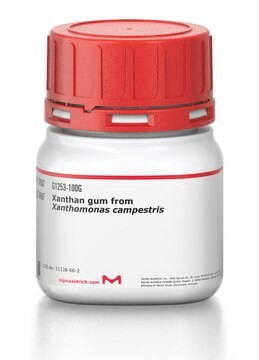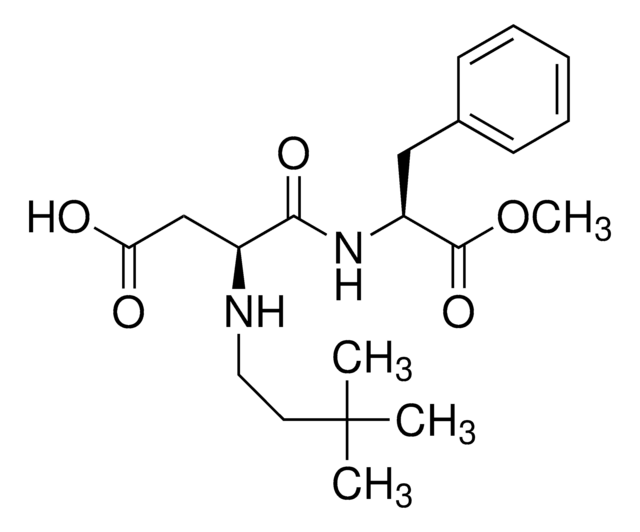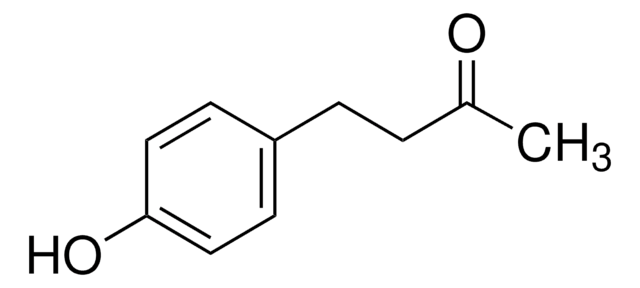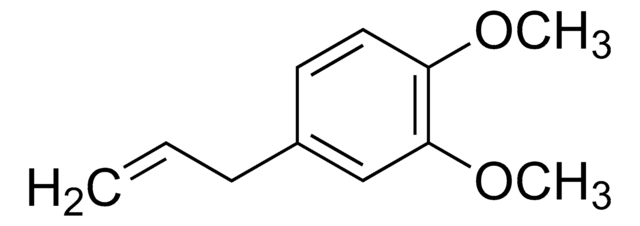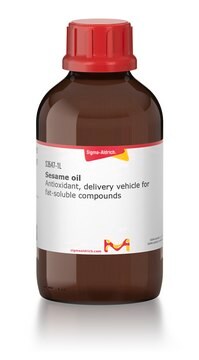W258814
4-(4-Hydroxyphenyl)-2-butanone
natural, ≥98%, FCC, FG
Synonym(s):
Frambione, NSC 26515, Raspberry ketone
About This Item
Recommended Products
grade
FG
Fragrance grade
Halal
Kosher
natural
Quality Level
Agency
follows IFRA guidelines
meets purity specifications of JECFA
reg. compliance
EU Regulation 1223/2009
EU Regulation 1334/2008 & 178/2002
FCC
FDA 21 CFR 117
Assay
≥98%
mp
81-85 °C (lit.)
application(s)
flavors and fragrances
Documentation
see Safety & Documentation for available documents
food allergen
no known allergens
fragrance allergen
no known allergens
Organoleptic
berry; jam; raspberry; sweet
SMILES string
CC(=O)CCc1ccc(O)cc1
InChI
1S/C10H12O2/c1-8(11)2-3-9-4-6-10(12)7-5-9/h4-7,12H,2-3H2,1H3
InChI key
NJGBTKGETPDVIK-UHFFFAOYSA-N
Looking for similar products? Visit Product Comparison Guide
Application
- Sex-Specific Effects on Total Body Fat Gain with 4-Week Daily Dosing of Raspberry Ketone [4-(4-Hydroxyphenyl)-2-butanone] and Ketogenic Diet in Mice.: This research investigates the effects of daily dosing of raspberry ketone on body fat and metabolic health, providing insights into gender-specific responses and potential therapeutic uses of raspberry ketone for obesity and metabolic syndrome (Hao L et al., 2023).
- Metabolic gene signature in white adipose tissue of oral doses raspberry ketone [4-(4-hydroxyphenyl)-2-butanone] that prevent diet-induced weight gain and induce loss of righting reflex.: This study delves into the molecular mechanisms through which raspberry ketone influences weight management and metabolic health, highlighting its potential applications in nutraceuticals and metabolic research (Kshatriya D et al., 2023).
- Reduced Body Fat and Epididymal Adipose Apelin Expression Associated With Raspberry Ketone [4-(4-Hydroxyphenyl)-2-Butanone] Weight Gain Prevention in High-Fat-Diet Fed Mice.: Demonstrates the bioactive properties of raspberry ketone in modulating fat metabolism and adipose tissue function, offering a potential strategy for combating obesity and related metabolic disorders (Hao L et al., 2021).
Signal Word
Warning
Hazard Statements
Hazard Classifications
Acute Tox. 4 Oral
Storage Class Code
11 - Combustible Solids
WGK
WGK 2
Flash Point(F)
Not applicable
Flash Point(C)
Not applicable
Personal Protective Equipment
Choose from one of the most recent versions:
Already Own This Product?
Find documentation for the products that you have recently purchased in the Document Library.
Customers Also Viewed
Our team of scientists has experience in all areas of research including Life Science, Material Science, Chemical Synthesis, Chromatography, Analytical and many others.
Contact Technical Service


